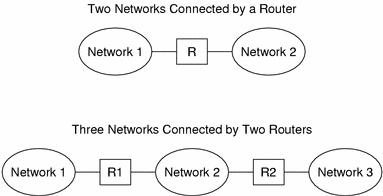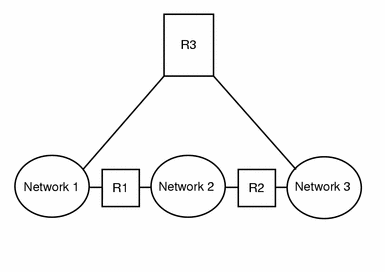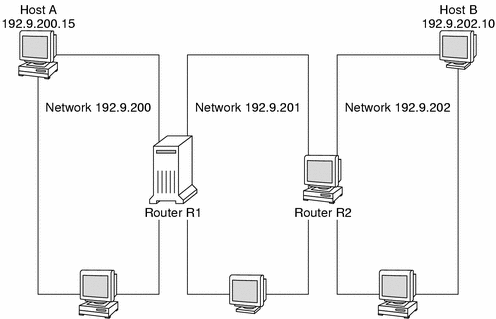Adding Routers
Recall that in TCP/IP, two types of entities exist on a network: hosts and routers. All networks must have hosts, while not all networks require routers. The physical topology of the network determines if you need routers. This section introduces the concepts of network topology and routing, important when you decide to add another network to your existing network environment.
Network Topology
Network topology describes how networks fit together. Routers are the entities that connect networks to each other. From a TCP/IP perspective, a router is any machine that has two or more network interfaces. However, the machine cannot function as a router until properly configured, as described in "Configuring Routers".
Routers connect two or more networks to form larger internetworks. The routers must be configured to pass packets between two adjacent networks. The routers also should be able to pass packets to networks that lie beyond the adjacent networks.
The following figure shows the basic parts of a network topology. The first illustration shows a simple configuration of two networks that are connected by a single router. The second illustration shows a configuration of three networks, interconnected by two routers. In the first example, router R joins network 1 and network 2 into a larger internetwork. In the second example, router R1 connects networks 1 and 2. Router R2 connects networks 2 and 3. The connections form a network that includes networks 1, 2, and 3.
Figure 3-1 Basic Network Topology

Routers join networks into internetworks. Routers also route packets between networks that are based on the addresses of the destination network. As internetworks grow more complex, each router must make more and more decisions about the packet destinations.
The following figure shows a more complex case. Router R3 directly connects networks 1 and 3. The redundancy improves reliability. If network 2 goes down, router R3 still provides a route between networks 1 and 3. You can interconnect many networks. However, the networks must use the same network protocols.
Figure 3-2 Providing an Additional Path Between Networks

How Routers Transfer Packets
The IP address of the recipient, a part of the packet header, determines how the packet is routed. If this address includes the network number of the local network, the packet goes directly to the host with that IP address. If the network number is not the local network, the packet goes to the router on the local network.
Routers maintain routing information in routing tables. These tables contain the IP address of the hosts and routers on the networks to which the router is connected. The tables also contain pointers to these networks. When a router receives a packet, the router consults its routing table to see if the table lists the destination address in the header. If the table does not contain the destination address, the router forwards the packet to another router that is listed in its routing table. Refer to "Configuring Routers" for detailed information on routers.
The following figure shows a network topology with three networks that are connected by two routers.
Figure 3-3 Three Interconnected Networks

Router R1 connects networks 192.9.200 and 192.9.201. Router R2 connects networks 192.9.201 and 192.9.202. If host A on network 192.9.200 sends a message to host B on network 192.9.202, the following events occur:
Host A sends a packet out over network 192.9.200. The packet header contains the IPv4 address of the recipient host B, 192.9.202.10.
None of the machines on network 192.9.200 has the IPv4 address 192.9.202.10. Therefore, router R1 accepts the packet.
Router R1 examines its routing tables. No machine on network 192.9.201 has the address 192.9.202.10. However, the routing tables do list router R2.
R1 then selects R2 as the "next hop" router. R1 sends the packet to R2.
Because R2 connects network 192.9.201 to 192.9.202, R2 has routing information for host B. Router R2 then forwards the packet to network 192.9.202, where host B accepts the packet.




